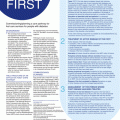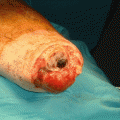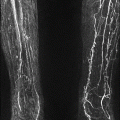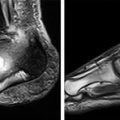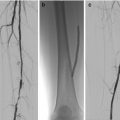Figure 16.1
A typical foot attack
The management of a foot attack requires the knowledge and skills of a diverse range of specialities and disciplines to provide optimal care and long-term reduction of risk of recurrence. The effectiveness of the MDT in the care of the diabetic foot cannot be underestimated [5]. Serial studies have demonstrated the improved outcomes, decreased complications and the cost-effectiveness of the MDT [2, 6, 7].
How Should This Work?
The definition of the MDT is often understood as incorporating only the clinicians within secondary care with very specialist expertise. In fact, the team is much larger and diverse, encompassing professionals from both primary and specialist care and also the patient throughout the course of their disease.
There are four key components to ensuring that the risk of developing foot complications in patients with diabetes is minimised. These are:
1.
Patient education
2.
The foot protection team
3.
The multidisciplinary team
4.
A foot care pathway
Patient Education
Patients and carers are key to recognising or alerting clinicians. Sometimes, it can be that the foot “is just not right.” This recognition is a challenge in some patients with diabetes who have sight problems, which prevent direct vision of their feet and therefore prevent them from identifying the subtle change within the foot. Similarly, neuropathy may mask the pain that would ordinarily trigger initial recognition of a new ulcer and autonomic neuropathy will ensure that a foot will remain warm to touch even with a compromised blood supply. The engagement of patients and carers in daily checks of their feet allows an early trigger when the foot is different from normal. It is then vital that patients and carers understand where they can find help and how quickly this should occur. Diabetes UK has recently produced a free booklet named “Recognising the Foot Attack,” which documents the signs to look out for and provides space to record the phone numbers of key contacts. Patient leaflets are available in many languages and are a way of encouraging conversations within a family or group.
All patients with diabetes should have a foot check as part of the annual diabetes surveillance.
This allows each patient to be triaged as normal, low risk, at risk or high risk of developing future diabetic foot complications [8]. It is important that this risk is explained clearly to patients and that they are then referred appropriately to the foot protection team.
The Foot Protection Team
The foot protection team (FPT) includes general practitioners, practice nurses, podiatrists, district nurses and diabetes specialist services. These are the core components of the triage system, which ensures patients are educated, risk-stratified and monitored to decrease the risk of progression to an acute foot attack. These are often located within community services but need to have rapid access and good communication with secondary care colleagues. Many members of the team may also have contracts to work within secondary care. This service should be seamless with that of the MDT in specialist care, allowing rapid and shared care pathways to occur both into and out of the services.
The absolute prevention of complications may not be possible, but their burden will be reduced by appropriate advice and early referral should they develop. All diabetic patients should be triaged and allocated a risk category (to be reviewed at least annually) [8]. Those assessed as being at risk or as low risk should be reviewed by the FPT as per agreed protocols. Each visit provides an opportunity to educate and re-educate the patient and their carers. This responsibility of the FPT for education extends to the education of fellow healthcare professionals, to adequately assess and stratify diabetic feet.
The FPT is essential to the management of selected cases in the community, i.e. patients who are high-risk or have active disease, who would otherwise require MDT management. Patients discharged back to nursing homes, care homes or with poor mobility or difficulty with transport may not be able to manage the regular secondary-care appointments required to monitor healing. The implementation of a shared-care protocol after discharge, with clear individual care planning, will reduce the risk of non-compliance and hospital re-admission. A successfully treated foot attack still places that individual as a high-risk patient and highlights the on-going need for long-term management plans.
These patients may need specialist footwear and off-loading devices as well as fundamental advice with regard to emollients and simple lifestyle advice, to include not walking in bare feet! Each patient needs to be counselled in the context of their lifestyle: the sole breadwinner for a family may need to work on a building site wearing the offending steel toe–capped boots, rather than wearing an off-loading cast, to ensure that they can work every day. The role of the FPT as an educator and patient advocate is crucial in ensuring patient compliance, which will reduce the risk of re-occurrence of diabetic foot complications.
Not every individual with diabetic foot disease can be looked after within secondary care and so a large support network in the community is essential is helping to manage these patients at home, and avoid un-necessary admissions.
The Multidisciplinary Team
Each hospital trust should have a named foot care MDT. It is difficult to delineate exactly whether this team needs to be “actual,” where all members meet regularly, or “virtual,” with an ability to put the right clinicians into the right environment at the right time for the individual patient. The team should include diabetologists, accident and emergency (A&E) consultants, vascular surgeons, orthopaedic and/or plastic surgeons, diagnostic and interventional radiologists, podiatrists/podiatric surgeons, microbiologist, tissue viability nurses (or nurses with knowledge and experience of wound dressing), diabetes specialist nurses, orthotists, physiotherapists, plaster technicians and rehabilitation specialists. The MDT should have access to the advice and skills of other professionals, including medical photography. Within the MDT, there should be a named clinical lead, who most frequently is a diabetologist by trade, but this will vary on the individual team and their availability.
In 2011, the National Diabetes Inpatient Audit (NaDIA) found that 75 hospital sites (40.5 %) did not have a multi-disciplinary team comprising a diabetologist with expertise in lower limb complications, a surgeon with expertise in managing diabetic foot problems, a diabetes specialist nurse, a specialist podiatrist and a tissue viability nurse. There had been no improvement from the previous year [9].
Referral criteria and referral pathways should be documented clearly and made accessible for the FPT, primary care practitioners and other non-specialists throughout the catchment area. A dedicated telephone and/or fax referral service should be available [10]. Referrals can be reviewed and directed onwards to the appropriate MDT discipline to be seen in the appropriate time period.
The sign-posting of the services of the multi-disciplinary team is of great significance, and the Diabetes UK patient information leaflets provide a space for this information to be documented. A&E staff must be aware of the needs of patients with diabetic foot complications and of the need for rapid intervention. The inclusion of the A&E consultant is crucial to ensuring patients are not referred appropriately to secondary care and then turned away by inexperienced frontline staff.
Stay updated, free articles. Join our Telegram channel

Full access? Get Clinical Tree



